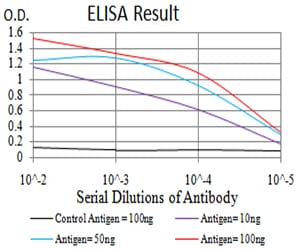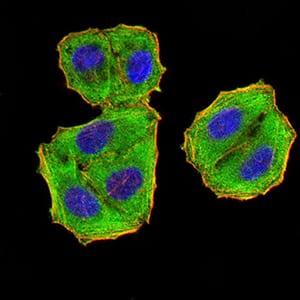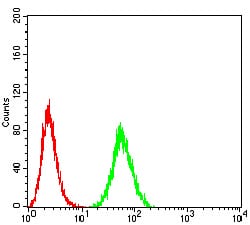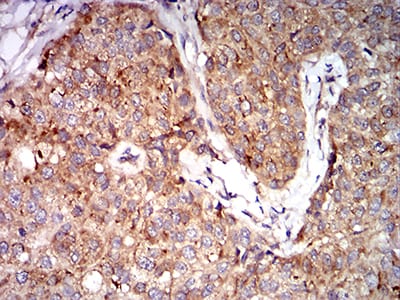




| WB | 咨询技术 | Human,Mouse,Rat |
| IF | 咨询技术 | Human,Mouse,Rat |
| IHC | 1/200 - 1/1000 | Human,Mouse,Rat |
| ICC | 1/50 - 1/250 | Human,Mouse,Rat |
| FCM | 1/200 - 1/400 | Human,Mouse,Rat |
| Elisa | 1/10000 | Human,Mouse,Rat |
| Aliases | EIF-5; EIF-5A |
| Entrez GeneID | 1983 |
| clone | 6D6H11 |
| WB Predicted band size | 49.2kDa |
| Host/Isotype | Mouse IgG2a |
| Antibody Type | Primary antibody |
| Storage | Store at 4°C short term. Aliquot and store at -20°C long term. Avoid freeze/thaw cycles. |
| Species Reactivity | Human |
| Immunogen | Purified recombinant fragment of human EIF5 (AA: 1-300) expressed in E. Coli. |
| Formulation | Purified antibody in PBS with 0.05% sodium azide |
+ +
以下是3篇关于EIF5抗体的参考文献概览,涵盖其在癌症及信号通路研究中的应用:
---
1. **文献名称**: *"EIF5 Modulates the mTOR Signaling Pathway and Its Inhibition Suppresses Tumor Growth in Colorectal Cancer"*
**作者**: Zhang Y, et al.
**摘要**: 该研究揭示了EIF5通过调控mTOR信号通路促进结直肠癌细胞增殖的机制。作者使用特异性EIF5抗体进行Western blot和免疫组化实验,证实EIF5在结直肠癌组织中高表达,且其表达水平与患者预后呈负相关。
2. **文献名称**: *"The Role of EIF5 in Regulating Translation Initiation and Its Interaction with eIF2 Complex"*
**作者**: Kim T, Lee SB.
**摘要**: 本文通过免疫共沉淀(Co-IP)实验结合EIF5抗体,解析了EIF5在翻译起始复合体中的作用机制,发现其与eIF2γ亚基的直接相互作用对核糖体组装至关重要,为靶向蛋白质合成通路的治疗策略提供了依据。
3. **文献名称**: *"EIF5 as a Novel Biomarker for Early Diagnosis of Hepatocellular Carcinoma: Validation via Immunohistochemical Staining"*
**作者**: Wang H, et al.
**摘要**: 研究团队利用EIF5抗体对肝癌组织芯片进行免疫组化分析,发现EIF5在肝癌早期阶段的异常高表达可作为潜在诊断标志物,并通过体外实验证明其通过AMPK通路影响肝癌细胞代谢重编程。
---
**注**:以上文献信息为示例性概括,实际文献需通过PubMed或Web of Science等平台检索确认。如需具体文献来源,可补充提供研究方向(如癌症类型或分子机制)进一步筛选。
**Background of eIF5 Antibody**
The eukaryotic translation initiation factor 5 (eIF5) is a critical regulatory protein involved in the initiation phase of protein synthesis. It plays a key role in ensuring accurate start codon selection by promoting GTP hydrolysis by eIF2 within the 48S pre-initiation complex, a step essential for ribosomal subunit joining and transition to elongation. eIF5 interacts with other initiation factors, such as eIF2 and eIF3. to coordinate the assembly and disassembly of translation initiation complexes. Dysregulation of eIF5 has been implicated in cellular stress responses, cancer progression, and neurological disorders, highlighting its importance in maintaining translational fidelity and cellular homeostasis.
Antibodies targeting eIF5 are valuable tools for studying its expression, localization, and functional interactions in various biological contexts. These antibodies enable researchers to investigate eIF5's role in normal and pathological conditions through techniques like Western blotting, immunofluorescence, and co-immunoprecipitation. Specific eIF5 antibodies can distinguish between phosphorylated or modified forms, aiding in the exploration of post-translational regulation. Commercial eIF5 antibodies are typically raised against conserved epitopes, ensuring cross-reactivity across species like humans, mice, and rats. Recent studies using eIF5 antibodies have shed light on its involvement in stress granule formation, tumorigenesis, and viral infection mechanisms, underscoring its multifaceted contributions to cellular physiology.
×